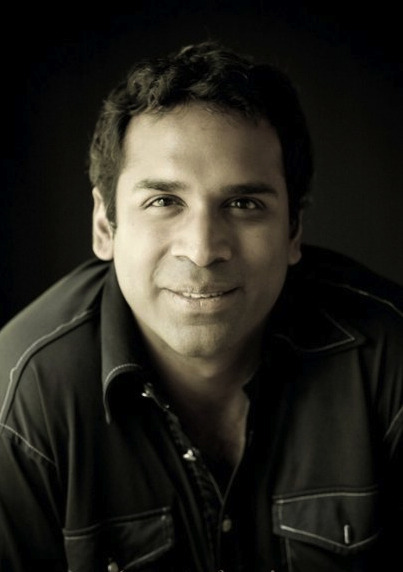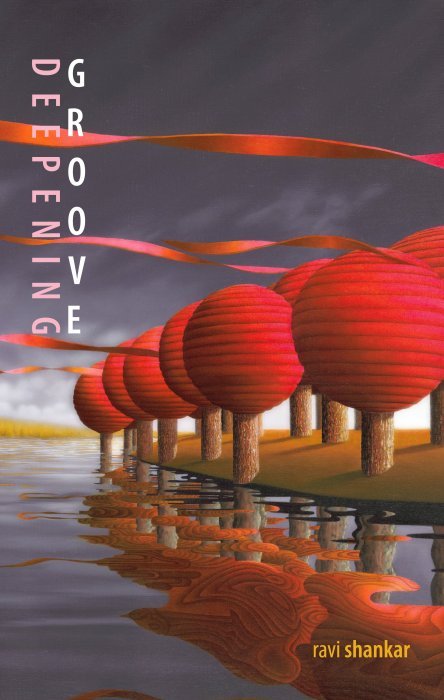Ravi Shankar, invitado al XXII Festival de Poesía, es el editor de uno de los más antiguos sitios electrónicos sobre arte, Drunken Boat. Nacido en 1975, se considera un "nómade posmoderno", como se lo dice a la Sociedad Poética de EEUU, una parodia de un indio. Creció en el estado de Virginia, como se lo hace saber a la Fundación de Poesía americana. Ganó el premio nacional de poesía reseñada por Deeping Groove (2011). Recogió la poesía de Asia, oriente medio y "más allá" según declara en esta entrevista. "Si hubiese conseguido una rupia por cada vez que alguien hacía un chiste sobre Woodstock --dice en este texto que publicó en el New York Times--, o cada vez que alguien pulsaba al aire una cítara mientras falseaba una voz nasal, o cada vez que alguien me pidió que arreglase una cita con mi hija Norah Jones, sería alguien mucho más rico. Es raro que pase un día sin que recuerde al músico de world music que es dueño de mi nombre. Viví mi vida como una doppelgänger, un Ravi Shankar secundario". Al final de ese texto agradece a Ravi Shankar por compartir su nombre aunque insiste en que Norah Jones no está entre su descendencia.
Sobre su antología "Lenguajes para un nuevo siglo", que reúne poetas de Asia y Medio Oriente, dice en Poems out loud: "La cuestión de la etnicidad es espinosa, sobre todo porque la colección fue editada por americanos. Tina Chang es chino-americano, soy indio-americano, y Nathalie Handal, aunque nacido en Palestina, es un ciudadano del mundo. El proyecto comenzó realmente con los poetas de la diáspora y se movió hacia afuera con poetas que escriben en sus lenguas originales. La idea de la representación étnica es de doble filo porque, por un lado, ayuda a crear comunidad y reúne a escritores que podrían tener experiencias similares, pero por otro lado, se puede delimitar el contenido, promulgan estereotipos y podría ser una lente inútil para evaluar el trabajo". Acá hay más sobre nuestro invitado.
—¿Cuál considerás que podría ser tu ars poética?
—Mi ars poetica está
incluida en el poema “On Style” (“Sobre el estilo”). En breve, creo que el
poema es una comunicación condensada que mezcla música, emoción y pensamiento
en una percepción reveladora.
On Style
Volcanic rocks are aphanitic, which is to say
that they are composed of such fine grains of minerals —feldspar, quartz,
biotite— that they are invisible to the naked eye yet texturally different than
obsidian or other forms of volcanic glass that are non-crystalline. Similarly,
the raw, mineral forms at the base of consciousness expend their agglutination
in music, shapes that shift perception the way a paradigm shatters when a new
theory changes prevailing notions. Our idea of what an atom is made from shifts
over time just as how words —a phrase, a proof, a stanza— show the trace of a
mind at work and in the process contribute a new way of looking or form of
reasoning, a metaphor that uncoils in invention or connects two parallel lines
of thought. If there’s chaos underlying shimmering pattern, there are flying
buttresses holding up the void, which spurts in plume and ash from volcanoes
that are active on 17 places in the world as I write this, smelting and turning
the sky incandescent with the earth’s innards.
Say style is ontological. It’s a mode of being
in the world so intractable from the mind’s syntactical manifestations that it
possesses clear inevitability and shares in the sheer delight of mathematical
proof. Literature while grounded in the sensory still verges to the purest form
of abstraction, expressed more fully perhaps only by music and math. Walter
Pater would have poetry be language that aspires to the condition of music and
the poem arrives distilled, impacted with meanings that collide, othering
itself just as it asks us to enter the speaker’s voice to share the pulse of
internal rhythm, narrative drive, a lyric suggesting, a certain mode of
perceiving that’s inseparable from the perception or from the use of repetition
that accumulates power through detail. But not just in poetry. Take
Hemmingway’s forceful staccato reportage, enclosed within a single point of
view (save in a work like For Whom the Bell Tolls) versus Proust’s satirizing
pastiches of Flaubert, which demonstrate in the words of Jed Deppman, “a
mastery of such Flaubertian techniques as free indirect style, ternary
structures, multiplication of the imperfect tense, and, most of all, what I
will call (rechristening a modernist term) impassibility.”
Style is impassable. Not baby-back, flared,
faded, beaded, skinnyrib, crocheted, cantilevered or pimped out proper, but
Beckett stripping syntax to bone and Joyce layering cakes of connotation.
Sappho writing such tremulously distinctive evocations that fragmentary work
found on papyrus even today can still be attributed to her. Tagore retaining
even in translation, what Yeats called a “lifting up into a greater intensity
of the mood of the painter, painting the dust and the sunlight. ” Not affect
but essence. A quality that transcends each jot of robot or ounce of flounce.
Not an imitation but the peacock itself: the abstract localized and concretized
into a blazing blue eye. Style cannot be dissected because it’s made of the
mere material of its movement in time. It’s like the transverse curve of a
mangrove root anchoring and absorbing, a sinuous prop to support the tree. Or
like shards of cliff polished into sand by the sea. What else could it
be but what it be?
This condition of being innately apart yet a
part of legibility is the defining characteristic of the text, but there’s
still a further boulder at the threshold of logos that prevents us from delving
too deeply into the true mystery of style. Because whether manifest as stride
or mouthed as a liquid, whether reflexively self-reflexive or flatly reasoned
into pure instinct, when the jellyroll rolls like a parade through town, the
observer needs stop drop-jawed to regard. No choice in the matter. Something so
funky, original, shocking but inevitable, the extension of the divine into the
basso profundo bossa nova of being suffusing the moment, even when it takes the
shape of boot cut denim shimmying to the backbone of a bass line or the
concatenation of clauses invoking Norse allusions and etymological puns. Style
inflects the natural order of things with variation. A metaphoric Darwinism
enacts, evolves, shifts and alters forever what might come before and
afterwards. Style might be period but it’s never the period period. Closer to
comma in creating new lanes of exchange, pushing outwards to make inroads into
something measured as both trochaic trimeter and the echocardiogram; the one
using sound to intensify the sonic exigency, front-loading the beat to echo
church hymnals, the other using ultrasound to show a cross-sectional slice of
the chambers and valves of the beating heart. Both creations help assess
direction and velocity. Both graph markings of living life in distinctive and
utterly necessary ways. And even as the opposite is also true, style remains
vital in a way that the cardiac sciences does not.
But unlike sincerity, can style can be
mechanized? Literature has its equivalent of Andy Warhol’s factory churning out
silk-screens or Sol LeWitt creating directions for assistants around the world
to produce works even years after he’s passed away. An algorithm for creating a
poem according to certain highly restrictive restraints can produce something
distinctive, even if not willed. And if over time the same algorithm with
different inputs produces similarly syncopated and delineated texts, then is
that style? Because one thing style marks is consistency. The one-off or the
lark into social realism, the occasional satirical send up or rare genre
experiment, don’t possess it the way Faulkner’s sentences, Charles Wright’s
stanzas, Chuck Close’s faces, Laurie Anderson’s performances, Mozart’s
symphonies, the lemon’s acidity, the polar bear’s haunches, and the upper
atmospheric condensation all do. Not as an integral part of their composition,
inseparable from their other qualities. One can read style all the way down to
the graviton’s induction of attraction between massless fermions. Even on that
microscopic level there are rules that result in wildly oscillating results. If
truth and pretense are forces pulling in opposite directions, style is that one
central fulcrum point where there’s relative stasis —and from which pivot all
aesthetic and scientific movement arises and arrives.
—¿Cómo está
presente la ciudad o tu lugar en tu poesía?
—Muy a menudo descubro que escribo mejor sobre un lugar del
que me fui. Hay un gran pasaje en el libro Triggering
Town, del reciente poeta americano Richard Hugo en el que discute acerca de
los riesgos de escribir sobre la ciudad en la que uno vive porque hay
demasiadas asociaciones y represiones acerca de la gente y los lugares que uno
conoce en su intimidad. De modo que recomienda transferir los poemas propios a
otra ciudad, real o inventada. Creo que todos los lugares en los que viví en el
pasado —Nueva York, San Francisco, Cyprus, el sur de la India—, todos se abren
camino en mi obra de un modo u otro, y creo que donde vivo ahora, un tranquilo
y quintaesencial poblado de Nueva Inglaterra al borde del río Connecticut, le
da forma a la periferia de mis percepciones, si es que directamente no influye
en todo el trabajo.
—¿De quién de tus contemporáneos te sentís más próximo? ¿Y de las generaciones anteriores?
—Los poetas contemporáneos que más admiro incluyen a Mary
Rueffle, Terrance Hayes, Vijay Seshadri and Anne Carson. Adoro a Hart Crane,
Wallace Stevens, Pablo Neruda, Forough Farrokhzad, Rumi, Rilke y César Vallejo
(el “César”, en la respuesta enviada en inglés, llega con el correcto tilde
español) de la generación pasada. Por supuesto que hay muchos poetas para
nombrar que están haciendo un trabajo interesante, pero el antiguo y sincero
ejercicio de verbalizar metafóricamente las propias percepciones es algo a lo
que siempre me siento profundamente conectado.
Lugar de trabajo.
—¿Cuáles
creés que son los cambios más visibles en la poesía actual?
—La novedad más interesante del siglo XXI fue el colapso de
muchos de los límites más usuales para separar las escuelas estéticas como la
de los poetas del lenguaje, los poetas confesionales, los formalistas y los
performáticos. Esos estrechos acampes estéticos ya no son tan interesantes y
hay ahora un montón de poesía híbrida que está escribiéndose en un aspecto mucho
más internacional y con un desarrollo más experimental. A la vez, me doy cuenta
de que los poetas aspiran a ser multimedia y colaborativos en sus afanes poéticos
y que el mundo menguó, de modo que estamos mucho ms al tanto de la poesía en
las regiones más extremas del orbe de lo que estuvimos en otros momentos de la
historia.




No hay comentarios:
Publicar un comentario